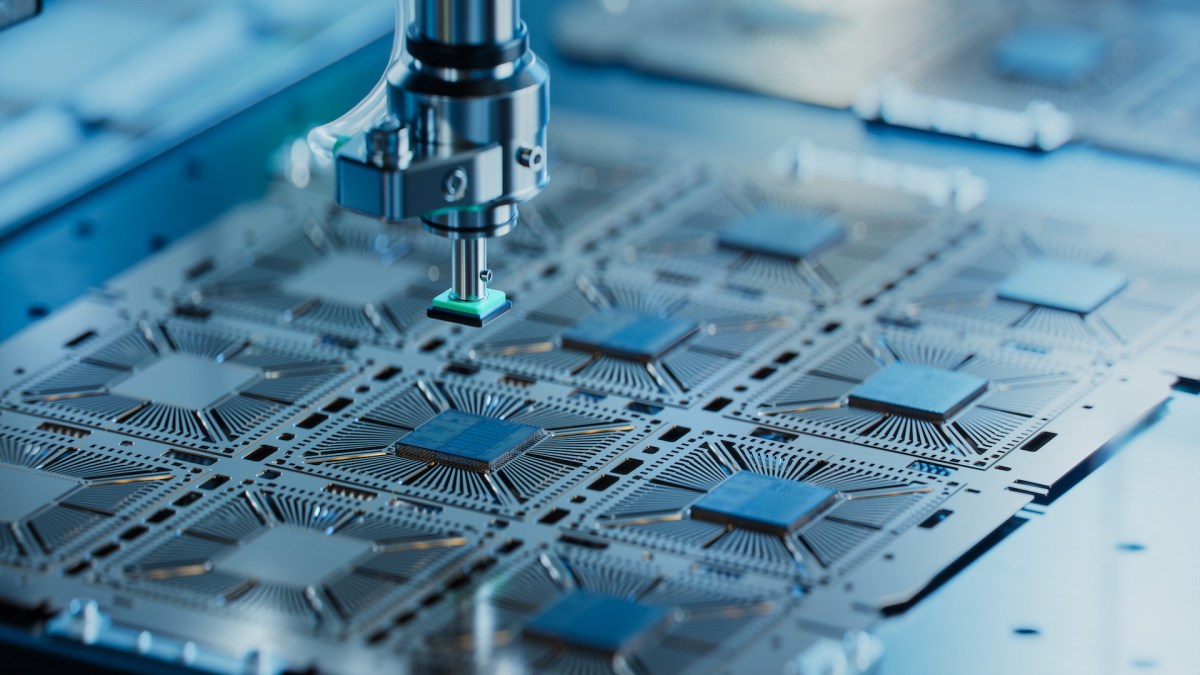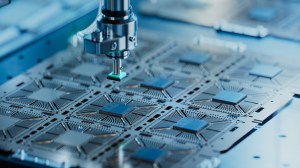Pentagon announces initial awards for $2B Microelectronics Commons program

The Pentagon has officially selected entities to enable its “Microelectronics Commons” program and make up the underpinning new network of regional innovation hubs envisioned to drastically drive the United States’ domestic manufacturing base of such circuits, chips and other small-scale electronic items in the near term.
Computer chips and microelectronics help power the military’s current and next-generation weapons systems and other crucial national security technologies. Historically, the U.S. has operated as a leader in the development of microelectronics globally. But according to a senior defense official, the nation has largely under-invested in the domestic production of such assets — so now, most are created overseas.
“In fact, the U.S. relies on East Asia for about 75% of global production as of today,” a senior official told reporters on Tuesday ahead of Wednesday’s announcement about the initial awards for the program.
Backed by millions in funding including via the 2022 CHIPS and Science Act — and with roots tracing back to a requirement under the fiscal 2021 National Defense Authorization Act to establish a National Network for Microelectronics Research and Development — the DOD’s Microelectronics Commons program is meant to encompass a national web of hubs that connect direct pathways to commercialization from laboratory to fabrication, for microelectronics researchers and designers across America.
“The one-liner, if you like, is the ‘lab-to-fab.’ But behind that … what we’re doing is to ensure that for the foreseeable future, the department has a robust pipeline that delivers new world-leading microelectronics, that draws on the massive number of innovative organizations across the country and is focused on the department’s demanding specialized needs — and that builds both our workforce for developing those devices, but also the larger workforce outside of these hubs and such that … now knows how to do it,” the senior defense official told reporters.
They added that it will be about “producing new tools, new software — just as we did originally, back in the” 1970s and ’80s, when the Pentagon through Defense Advanced Research Projects Agency (DARPA) facilitated massive investments and a deliberate push to bolster America’s then-limited silicon foundries.
During a press briefing at the Pentagon on Wednesday, Deputy Secretary of Defense Kathleen Hicks said the initiative will help the technology cross “that infamous valley of death between research and development and production. Because while America is a world leader in the innovative research and design of microelectronics, we’ve lagged in the ability to prototype, manufacture, and produce them at scale. That’s what the CHIPS Act is meant to supercharge.”
For the new Commons program, the DOD released a request for proposals and relevant solutions in late 2022.
The first awards, with a total value of nearly $240 million dollars, will go toward the following eight regional innovation hubs:
- In New York, where SUNY Polytechnic and its 51 hub members will launch
the Northeast Regional Defense Tech Hub.
- In Arizona, where ASU and its 27 hub members will launch the Southwest
Advanced Prototyping Hub. - In North Carolina, where NC State and its seven hub members will launch
the Commercial Leap Ahead for Wide-bandgap Semiconductors Hub. - In Indiana, where the Applied Research Institute and its 130 hub members
will launch the Silicon Crossroads Microelectronics Commons Hub. - In Ohio, where the Midwest Microelectronics Consortium will launch a hub
with its 65 members. - In southern California, where USC and its 16 hub members will launch the
California Defense Ready Electronics and Microdevices Superhub. - In New England, where the Massachusetts Technology Collaborative and its
90 hub members will launch the Northeast Microelectronics Coalition Hub. - And in northern California, where Stanford, Cal Berkeley, and their 44 hub
members will launch the California-Pacific-Northwest Artificial Intelligence
Hardware Hub.
More than 360 different organizations were tapped to work via the hubs, which will provide the broader physical infrastructure, software tools and expertise needed to drive manufacturing and innovation.
Organizations that didn’t receive any of the initial awards will still have the opportunity to compete for opportunities that will open up over the next few years, Hicks noted.
The hubs in this new network will provide access to prototyping and development resources across six areas: electronic warfare; internet-of-things computing; artificial intelligence at the edge; quantum technology; 5G and 6G technology; and “leap-ahead” commercial technologies.
“Consistent with our warfighter-centric approach, the Microelectronics Commons will get the most cutting-edge microchips into systems our troops use every day: ships, planes, tanks, long-range munitions, communications gear, sensors, and much more, including the kinds of all-domain, attritable autonomous systems that we’ll be fielding through DoD’s recently-announced Replicator initiative,” Hicks said.
The Pentagon plans to spend about $2 billion over the next five years on the initiative, according to Deputy Undersecretary of Defense for Research and Engineering David Honey.
The senior defense official who briefed reporters on Tuesday said the first call for projects will go out in about a month.
“The areas of expertise [these hubs] are developing, or already have and are developing, are very much focused on the challenges that we have in the department. The projects that come through will be focused on a mix of the very near term and slightly longer term — we left it up. But the outcome of the central project will be something that can be taken to scale in a U.S.-based foundry,” the official told DefenseScoop during the press call.
On Wednesday, Honey said: “Now that we have selected the hubs, which will provide the laboratory fab infrastructure for R&D and other innovative development projects, our next solicitation … will be the call for project solicitations, which is scheduled to occur very soon. And then each year in the third quarter of the fiscal year, there will be additional calls for projects as that gets released.”
Pentagon officials hope that these hubs will attract significant non-DOD business and become self-sufficient.
An organization does not need to be a member of a hub to submit a project topic. The hubs are also intended to serve as a resource for commercial users and other U.S. government organizations outside of the Commons program and outside the DOD. And organizations don’t need a DOD contract to leverage the hubs, Honey noted.
Hicks told DefenseScoop that the Pentagon is essentially putting out “needs statements” about the types of microelectronics the department wants.
“The Department of Defense is like any other consumer in the following way we consume microelectronics that are out on the commercial market. What Microelectronics Commons does is helps us inject into that system the specific needs that we have … We help to direct investment like we do anywhere else we put government R&D. That’s what we’re going to be able to do here is to drive with our dollars the specific investment areas we need. And then as a consumer out the other end of that, however it produces, if you will, the fact that we can get that out of United States manufacturing is more secure for our supply chain,” she said.
The hubs are meant to be part of the broader microelectronics ecosystem, she noted.
“At the end of that ecosystem are fabs, and the fabs actually are the ones that end up producing. We have fabs elsewhere in the world. We will still have those allied based fabs, if you will, but what we’re doing here is generating a lot more ingenuity in that fab process in the United States and gearing it up through these hubs with a lot of energy on the types of microelectronics, on the types of problem sets that we need those fabs to produce at the other end. And yes, then we will be purchasing them — what is produced out of U.S. fabs alongside, again, some that are located in allied countries,” she added.
Honey told DefenseScoop that the Pentagon’s R&E directorate will be informing other Defense Department components about what the hubs are up to.
“We will be educating the services, the folks who write the requirements on what’s going on in the Commons so that as they’re thinking about the future requirements that they’re going to establish [and] what the opportunities are for future weapons systems development, they’re aware of the state of the art, you know, what’s coming through the Commons so they can then set — if they choose to do so — they can set the expectations in future solicitations for the kind of capabilities that they want,” he said.
Officials hope the hubs help generate chips that are available for use in the next few years.
“My expectation is that you’ll probably see chips coming through this well before the five years when the program is over. We should already see, I’m guessing, product coming out and stuff that’s available for use,” Honey said.
The Pentagon is set to host its first annual Microelectronics Commons meeting in Washington Oct. 17-18, where more information will be shared and attendees will be able to engage DOD officials and all the hubs.
There will be “opportunity for anyone that’s interested in working in the hubs or working with the hubs or through the hubs to hear what’s available,” Honey said.
“Within each of the … six tech areas, there’s a lot of opportunity for developments that would benefit the DOD. And so the folks from the government team that will be there are those researchers and program managers who have experience in developing the weapons systems … What they’ll be doing at the unclassified level is sharing their insights and where they think the greatest opportunities are for innovation and development coming through the hubs that would lead to an advantage for our systems,” he added.
There’s also a website for those who are interested in the program.






